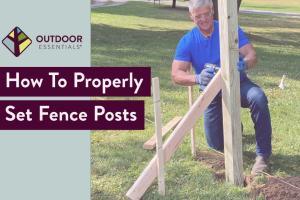Your Comprehensive Guide to Properly Placing Fence Posts in the Ground

-
Quick Links:
- Introduction
- Materials Needed
- Planning Your Fence
- Measuring and Marking the Fence Line
- Digging Post Holes
- Setting the Posts
- Backfilling and Finishing
- Maintaining Your Fence
- Case Studies
- Expert Insights
- FAQs
Introduction
Placing fence posts in the ground is a fundamental task that can significantly impact the longevity and stability of your fence. Whether you are looking to enclose a garden, create privacy, or define boundaries, understanding how to properly install fence posts is crucial. This comprehensive guide will walk you through the entire process, from planning to maintenance, ensuring that you achieve a durable and aesthetically pleasing fence.
Materials Needed
Before you get started, gather the following materials:
- Fence posts (wood, vinyl, or metal)
- Concrete mix or gravel
- Shovel or post-hole digger
- Level
- Measuring tape
- String line
- Hammer or mallet
- Protective gear (gloves, goggles)
Planning Your Fence
Planning is essential to achieve a well-structured fence. Consider the following:
- Purpose of the fence (privacy, security, decoration)
- Local zoning regulations and property lines
- Type of fence material
- Soil conditions and climate
Measuring and Marking the Fence Line
Once you have a plan, it's time to measure the fence line:
- Use a measuring tape to determine the total length of the fence.
- Mark the locations for your posts using stakes and string lines.
- Ensure posts are spaced evenly, typically 6-8 feet apart.
Digging Post Holes
Proper hole depth is crucial for stability. Here’s how to dig post holes:
- The depth should generally be one-third of the total post length.
- Use a post-hole digger to create holes approximately 10-12 inches wide.
- Remove any loose soil and debris from the holes.
Setting the Posts
Follow these steps to set your fence posts effectively:
- Place the post into the center of the hole.
- Use a level to ensure the post is straight.
- Fill the hole with concrete mix or gravel, packing it tightly around the post.
- Allow the concrete to cure as per manufacturer instructions.
Backfilling and Finishing
After the posts have set, backfill the holes:
- Fill around the post with soil, tamping it down to eliminate air pockets.
- Level the surrounding area to prevent water pooling.
Maintaining Your Fence
Regular maintenance can extend the life of your fence:
- Inspect posts for stability and wear.
- Repaint or stain wooden posts to protect against weather.
- Check for and remove any vegetation that might compromise the fence.
Case Studies
Several homeowners have successfully installed their own fences with varying materials and methods. For instance:
- A suburban family opted for a wooden fence and used pressure-treated posts, leading to a durable installation that has lasted over a decade.
- An urban couple chose vinyl fencing for its low maintenance, while ensuring proper installation techniques, resulting in a stylish and functional boundary.
Expert Insights
Industry experts suggest that the most common mistake is not digging deep enough for posts. Additionally, using a concrete mix can greatly enhance stability, especially in windy areas. Regularly checking alignment and stability after installation can save you time and money in the long run.
FAQs
- What is the best depth for fence posts?
- The best depth is typically one-third of the post length, ensuring stability.
- How long does concrete take to set for fence posts?
- Concrete generally takes 24 to 48 hours to set, depending on weather conditions.
- Can I use gravel instead of concrete?
- Yes, gravel can be used for drainage but may not provide the same stability as concrete.
- What spacing is recommended for fence posts?
- Posts should be spaced 6 to 8 feet apart, depending on the type of fence.
- How do I maintain my fence after installation?
- Inspect regularly, treat wood surfaces, and ensure proper drainage around posts.
- What type of post is best for my fence?
- Wood, vinyl, and metal each have their benefits—choose based on your specific needs and aesthetics.
- Can I install a fence post in rocky soil?
- Yes, but you may need specialized tools like a jackhammer or post hole auger.
- What are the benefits of using treated wood posts?
- Treated wood is resistant to rot and pests, extending the life of your fence.
- How do I know if my posts are level?
- Use a level during installation to ensure each post is straight.
- Are there local regulations for fence installation?
- Yes, check with local zoning laws and homeowners’ associations for guidelines.
Random Reads
- Using rufus create bootable usb drives
- Vizio tv wifi without remote
- How to set up your voicemail on android
- How to speed up browsers
- How to speed up downloads idm
- How to set a ringtone from a song on iphone
- The ultimate guide to making money in the sims 3
- Where and how to find emeralds in minecraft
- How to remove glass from garbage disposal
- How to remove gift card amazon